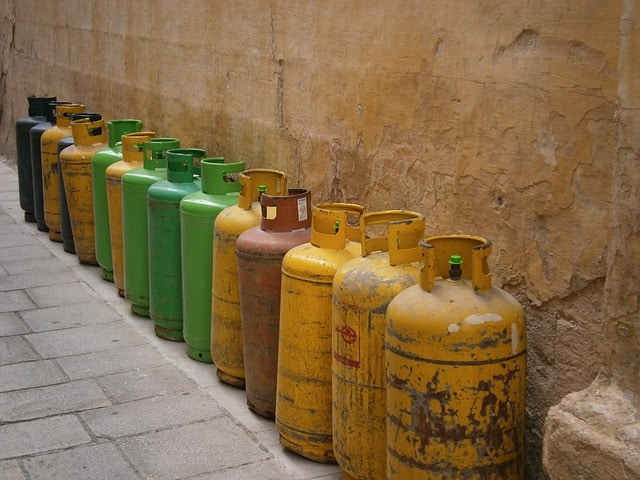When it comes to hazard classification, the GHS criteria are designed to be consistent, transparent, and draw a clear distinction between various classes and categories for companies and individuals.
The physical hazards classification process provides specific references to approved test methods and criteria for classification. The GHS physical hazard criteria apply to mixtures under the assumption that said mixtures will be tested for physical hazards. Previously, there were many different systems across the world that had similar qualitative criteria for various physical hazards.
 GHS defines the following physical states:
GHS defines the following physical states:
- Gas: a substance or mixture which has a vapor pressure greater than 300 kPa at 50°C; or is completely gaseous at 20°C and has a standard pressure of 101.3 kPa.
- Liquid: a substance or mixture that is not a gas and has a melting point or initial melting point of 20°C or less at a standard pressure of 101.3 kPa.
- Solid: a substance or mixture that does not meet the definitions of a liquid or a gas.
Below is a list of the different types of physical hazards and a brief overview of physical hazard classification criteria. For more complete information on GHS implementation, please consult the GHS Purple Book.
1. Explosives: A solid or liquid which is capable, by chemical reaction, of producing gas at a temperature, pressure, and speed as to cause damage to the surroundings. A pyrotechnic substance (or mixture) is designed to produce an effect by heat, light, sound, gas or smoke, or a combination of any of these as the result of non-detonative, self-sustaining, exothermic chemical reactions
a. Explosives have six hazard divisions they can be assigned to:
i. Mass explosion hazard
ii. Projection hazard
iii. Fire hazard for minor projection hazard
iv. No significant hazard
v. Very insensitive substances with mass explosion hazard
vi. Extremely insensitive articles with no mass explosion hazard
2. Flammable Gases: A gas having a flammable range in the air at 20°C and a standard pressure of 101.3 kPa.
a. Substances and mixtures of this hazard class are assigned to one of two hazard categories on the basis of the outcome of the test or calculation method
3. Flammable Aerosols: Aerosols are considered nonflammable if the concentration of flammable components ≤ 1% and the heat of combustion is < 20kJ/g, and extremely flammable if the concentration of the flammable components is > 85% and the heat of combustion is ≥ 30kJ/g.
a. Aerosols are classified as either a Category 1 or Category 2 flammable aerosol based on the following criteria:
i. Concentration of flammable components
ii.Chemical heat of combustion (mainly for transport/storage)
iii. Results from the foam test (foam aerosols) (mainly for worker/consumer)
iv. Ignition distance test (spray aerosols) (mainly for worker/consumer)
v. Enclosed space test (spray aerosols) (mainly for worker/consumer)
4. Oxidizing Gases: Any gas which may, generally by providing oxygen, cause or contribute to the combustion of other material more than air does.
5. Gases Under Pressure: Gases that are contained in a receptacle at a pressure not less than 280 Pa at 20°C or as a refrigerated liquid.
a. There are four types of gases or gaseous mixtures that address the effects of sudden release of pressure or freezing which may lead to serious damage to people, property, or the environment:
i. Compressed gas: entirely gaseous at -50°C
ii. Liquefied gas: partially liquid at temperatures > -50°C
iii. Refrigerated liquefied gas: partially liquid because of its low temperature
iv. Dissolved gas: dissolved in a liquid phase solvent
b. For this group of gases, the following information is required:
i. Vapor pressure at 50°C
ii. Physical state at 20°C at standard ambient pressure
iii. Critical temperature
6. Flammable Liquids: A liquid with a flash point of no more than 93°C.
a. Substances and mixtures of this hazard class are assigned one of four hazard categories:
i. Category 1: Flash point < 23°C and initial boiling point ≤ 35°C
ii. Category 2: Flash point < 23°C and initial boiling point > 35°C
iii. Category 3: Flash point ≥ 23°C and ≤ 60°C
iv. Category 4: Flash point ≥ 60°C and ≤ 93°C
7. Flammable Solids: Solids that are readily combustible or may cause or contribute to fire through friction. Readily combustible solids are powdered, granular, or pasty substances which are dangerous if they can be easily ignited by brief contact with an ignition source, such as a burning match, and if the flame spreads rapidly.
a. Flammable solids are assigned one of two hazard categories:
i. Category 1: burn time ≤ 5 minutes (metal powders only); or wetted zone does not stop fire and burning time < 45 seconds or burning > 2.2 mm/second
ii. Category 2: burning time > 5 and ≤ 10 minutes (metal powders only); or wetted zone stops fire for at least 4 minutes and burning time < 45 seconds or burning > 2.2 mm/second
8. Self-Reactive Substances: Thermally unstable liquids or solids liable to undergo a strongly exothermic thermal decomposition even without participation of oxygen. This definition excludes materials classified under GHS as explosive, organic peroxides, or as oxidizing.
a. There are exceptions to the self-reactive classification for substances with:
i. heat of decomposition < 300 J/g or
ii. self-accelerating decomposition temperature > 75°C for a 50 kg package
b. There are seven “types” that substances and mixtures can be assigned to:
Type A: Can detonate or deflagrate rapidly, as packaged
Type B: Possesses explosive properties and which, as packaged, neither detonates nor deflagrates, but is liable to undergo a thermal explosion
Type C: Possesses explosive properties when the substance or mixture as packaged cannot detonate or deflagrate rapidly or undergo a thermal explosion
Type D: Detonates partially, does not deflagrate rapidly and shows no violent effect when heated under confinement; or does not detonate at all, deflagrates slowly and shows no violent effect when heated under confinement; or does not detonate or deflagrate at all and shows a medium effect when heated under confinement
Type E: Neither detonates nor deflagrates at all and shows low or no effect when heated under confinement
Type F: Neither detonates in the cavitated bubble state nor deflagrates at all and shows only a low or no effect when heated under confinement as well as low or no explosive power
Type G: Neither detonates in the cavitated state nor deflagrates and shows non-effect when heated under confinement nor any explosive power, provided that it is thermally stable and, for liquid mixtures, a diluent having a boiling point > 150°C is used for desensitization.
9. Pyrophoric Liquids: A liquid which, even in small quantities, is liable to ignite within five minutes after coming into contact with air.
a. Substances and mixtures of this hazard class are assigned to a single hazard category on the basis of the outcome of the UN Manual of Tests and Criteria Test N.3
10. Pyrophoric Solids: A solid which, even in small quantities, is liable to ignite within five minutes after coming into contact with air.
a. Substances and mixtures of this hazard class are assigned to a single hazard category on the basis of the outcome of the UN Manual of Tests and Criteria Test N.2
11. Self-Heating Substances: A solid or liquid other than a pyrophoric substance which, by reaction with air and without an external energy supply, is liable to self-heat. This differs from pyrophoric substances in that it will ignite only when in large amounts (kilograms) and after long periods of time (hours or days).
a. Substances and mixtures of this hazard class are assigned to a single hazard category on the basis of the outcome of the UN Manual of Tests and Criteria Test N.4
12. Substances which, in contact with water, emit flammable gases: Solids or liquids which, when in contact with water, are liable to become spontaneously flammable or to give off flammable gases in dangerous quantities
a. Substances and mixtures of this hazard class are assigned one of three hazard categories, which is based on the speed of gas evolution:
Category 1: ≥10 L/kg/1 minute
Category 2: ≥20 L/kg/ 1 hour + < 10 L/kg/1 min
Category 3: ≥1 L/kg/1 hour + < 20 L/kg/1 hour
Category 4: < 1 L/kg/1 hour
13. Oxidizing Liquids: A liquid that might not necessarily be combustible but by yielding oxygen, may cause or contribute to the combustion of another material.
a. Substances and mixtures of this hazard class are assigned to one of three hazard categories on the basis of ignition or pressure rise time compared to defined mixtures.
14. Oxidizing Solids: A solid that might not necessarily be combustible but by yielding oxygen, may cause or contribute to the combustion of other material
15. Organic Peroxides: An organic liquid or solid which contains the bivalent -0-0- structure and may be considered a derivative of hydrogen peroxide, where one or both of the hydrogen atoms have been replaced by organic radicals. The term also includes organic peroxide formulations (mixtures).
a. Such substances and mixtures may:
be liable to explosive decomposition
burn rapidly
be sensitive to impact or friction
react dangerously with other substances
b. Substances and mixtures of this hazard class are assigned to one of seven types:
i. Type A: Can detonate or deflagrate rapidly, as packaged
ii. Type B: Possess explosive properties and which, as packaged, neither detonates nor deflagrates rapidly, but is liable to undergo a thermal explosion in that package.
iii. Type C: Possess explosive properties when the substance or mixture as packaged cannot detonate or deflagrate rapidly or undergo a thermal explosion
iv. Type D: Detonates partially, does not deflagrate rapidly, and shows no violent effect when heated under confinement; or does not detonate at all, deflagrates slowly and shows no violent effect when heated under confinement; or does not detonate or deflagrate at all and shows a medium effect when heated under confinement
v. Type E: Neither detonates nor deflagrates at all and shows low or no effect when heated under confinement.
vi. Type F: Neither detonates in the caviated bubble state nor deflagrates at all and shows only a low or no effect when heated under confinements as well as low or non-explosive power.
vii. Type G: Neither detonates in the caviated state nor deflagrates at all and shows no effect when heated under confinement nor any explosive power, provided it is thermally stable and, for liquid mixtures, a diluent having a boiling point > 150°C is used for desensitization.
16. Corrosive to Metals: A substance or a mixture that, by chemical action, will materially damage or even destroy metals. The GHS criteria are a corrosion rate on steel or aluminum surfaces exceeding 6.25mm per year at a test temperature of 55°C.






